calsfoundation@cals.org
Strawberry Industry
The strawberry industry arose in Arkansas in the late nineteenth and early twentieth centuries when the advent of railroads made possible the profitable shipping of the fruit. For farmers, especially those who sell their crops locally, strawberries “kick off” the growing season because of their early ripening. By the time strawberry plants have stopped producing, other fruits and vegetables are ready to be brought to market, thus allowing a savvy grower to stagger crops throughout the summer and into fall. According to rough estimates, there are about 200 acres of strawberries in Arkansas.
The short-lived peak market time of the strawberry originally prevented the fruit from getting a foothold in early Arkansas. Limited transportation meant poor-quality fruit at the stores or fruit stands in the city. A two- or three-day trip by mule cart or oxen would result in a load of moldy fruit. Only when the growing regions in the fertile river valleys were reached by the railroad, especially those with fast service and refrigerated cars, were growers able to ship from remote towns to larger cities with little loss, thus leading to an expansion of strawberry operations in the state.
Daniel W. Wheaton is credited with planting the first successful strawberry crop in White County. Other area farmers quickly imitated his success. Jacob C. Bauer started the Bauer Plant Company, which grew and sold strawberry plants. Louis Hubach developed new varieties of stronger plants with better fruit. The industry enjoyed a peak year in 1921, suffered setbacks due to plant disease in 1922 and 1923, then continued to grow and prosper even during the years of the Great Depression. Lack of farm labor and the inability to mechanize berry picking, however, led to a lessening of the strawberry’s importance after World War II.
The locations where strawberries could be profitably grown were limited because the berry business needed railroads, level land for fields, non-rocky soil, plenty of water for irrigation (without the land being swampy), and a moderate climate with late frosts and freezing. The strip of land that follows present-day Highway 67/167 from Jacksonville (Pulaski County) to Newport (Jackson County) was the major location for growing strawberries, especially such towns as McRae (White County) and Bald Knob (White County). A second major site was the Arkansas Valley from Conway (Faulkner County) to Van Buren (Crawford County).
White County is fairly representative of strawberry production in Arkansas in the early twentieth century. In the early 1900s, a McRae box factory’s entire output was used for the shipping of strawberries, and strawberry production constituted the largest industry in the town, even when compared to cotton and timber operations. The McRae Strawberry Association was created in 1912. Other towns such as Judsonia (White County), Bald Knob, Searcy (White County), and Beebe (White County) were also major sites of production, complete with warehouses and canneries. The growth of the industry led to an increase in tenant farming in White County, and the emergence of cooperatives provided for the cheaper export of berries across the country, with shipping by truck becoming common in the 1930s. In 1938, county agents in Searcy County organized a cooperative marketing association—Flintrock Strawberry Growers Association—to help growers in obtaining supplies and marketing. The flintrock ridges of eastern Searcy County became a major strawberry growing area, peaking in the mid-1950s.
The railroad led to the emergence of Arkansas’s strawberry industry, but other innovations in transportation, such as the shipping of berries via refrigerated truck, actually led to its decline, especially as it became possible to ship berries from areas of the country more suitable to the cultivation of strawberries. For berries to grow to be their sweetest, the weather has to be warm and sunny. Cold and rainy weather produces inferior berries. The state of California, which ranks first in the nation in strawberry production, possesses an environment that allows production to go on throughout the year. Florida cultivators can raise and pick their berries for six months of the year. By contrast, the strawberry season in Arkansas consists of only about six weeks. By the 1950s, the local industry declined in the face of the competition from other states, combined with the post–World War II migration of younger people to the cities. However, a number of growers continued to cultivate strawberries, especially for the local market and for farmers’ markets, and noteworthy farms are located in Cabot (Lonoke County), Judsonia, and Clarksville (Johnson County). But Arkansas in the twenty-first century produces very little of the nation’s strawberry crop.
Some modern agricultural methods that have helped strawberry growers are plasticulture, fertilizer, pesticides, and genetic improvement of plants. Probably the most important innovation regarding strawberry farming is plasticulture, a farming technique whereby tens of thousands of young strawberry plants or “plugs” per acre are planted in raised beds that have been covered with heavy plastic. Before young strawberry plants are put in the ground, the soil is prepared by fumigation with methyl bromide and chloropicrin. This pesticide combination kills soil nematodes, diseases, insects, and weeds. Although it does not remain in the plant or soil, many countries have banned methyl bromide’s use due to its effect upon the earth’s ozone layer. However, the U.S. Congress was heavily lobbied by the chemical industry, with the result that methyl bromide’s use is not banned but is limited to certain agricultural industries, including strawberries.
One of the most important problems in production of strawberries is finding labor, making it common for farmers to hire laborers from Latin American countries. Another major problem is land usage. Growing strawberries takes acres of good, fertile, level, non-rocky land. Those in the “u-pick” business also need land close to markets. However, in Cabot, for example, land adjacent to strawberry fields is quickly being developed by the housing market and by strip malls. It is not unusual for this land to sell for more than $5,000 to $10,000 an acre.
For additional information:
Cook, Bruce. The History of McRae, Arkansas. Searcy, AR: Harding University Press, 1981.
Johnson, Lincoln, and Elizabeth Short. In and Around the Big Rock: A History of Bald Knob, Arkansas. Columbus, GA: Quill Publications, 1988.
Orr, W. W. That’s Judsonia. Judsonia: White County Printing Corporation, 1957.
Miller, Paul E. “Strawberry Heyday.” White County Heritage 45 (2007): 7–10.
“Plans Strawberry Association.” Mountain Wave (Marshall, AR), June 8, 1912.
Deborah Moore
Ward, Arkansas
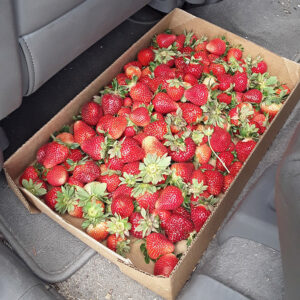 Cadron Crest Strawberries
Cadron Crest Strawberries  The Favored Strawberry
The Favored Strawberry 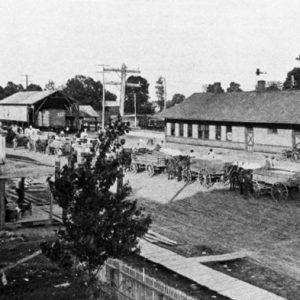 Judsonia Strawberry Wagons
Judsonia Strawberry Wagons 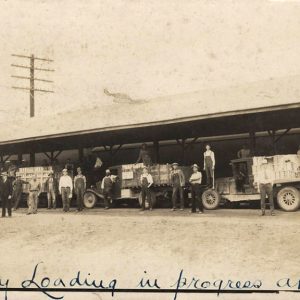 Loading Berries
Loading Berries 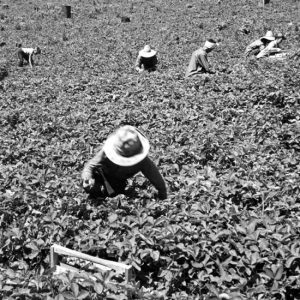 Marshall Strawberry Pickers
Marshall Strawberry Pickers 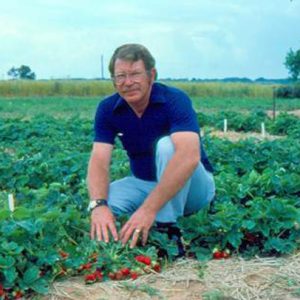 Jim Moore
Jim Moore 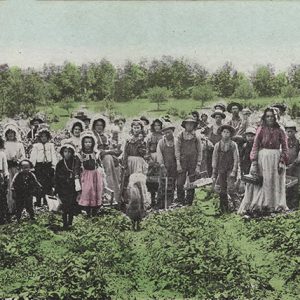 Strawberry Farm
Strawberry Farm  Strawberry Festival
Strawberry Festival 




Flintrock Strawberries: Strawberry growing in Searcy County had a long history, peaking in the mid-1950s with 457 farmers growing strawberries on 1,800 acres to sell 172,868 24-quart crates for $978,365. The Flintrock Strawberry Association was formed in 1912; by 1915, the association shipped 1,680 crates of strawberries from Zack using the cool Blowing Cave to await shipment on the Missouri and North Arkansas Railroad. In 1928, Henry Eaton brought in Blakemore berries, which became the preferred berry. In December 1938, county agents organized a cooperative marketing associationFlintrock Strawberry Growers Associationto help growers in obtaining supplies and marketing. The flintrock ridges of eastern Searcy County became a major strawberry growing area. Buyers as far away as Michigan liked the clean Flintrock berries grown on the rocky ground. The rows ran up and down the hillsides, because horizontal chevron rows created gullies. Pickers originally were local women and children, but increased acreage brought in Hispanic Americans from Texas to pick the seasonal crop. Loss of Hispanic workers due to Labor Department regulations in the 1960s ended the dependable labor supply. Acreages in production decreased, volume went down, and large buyers left. The strawberry crop was reduced to a few acres and, by 1986, only thirty growers farmed fifty to sixty acres for the Flintrock Strawberry Growers Association. By 2010, only a couple of growers grew strawberries for sale and the Flintrock Association was defunct.